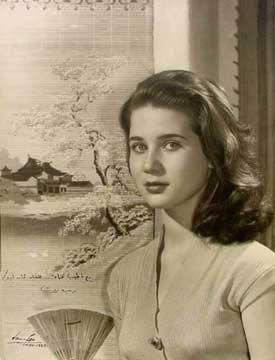Top Qs
Timeline
Chat
Perspective
Zubaida Tharwat
Egyptian actress (1940–2016) From Wikipedia, the free encyclopedia
Remove ads
Zubaida Ahmed Tharwat (Arabic: زبيدة أحمد ثروت; 15 June 1940 – 13 December 2016), was an Egyptian film, stage and television actress. She started her acting career in 1956, and quickly rose to stardom in Egypt. After six years hiatus in the 1960s, she returned to acting in 1969, and retired from acting in the 1980s. Tharwat was known as "the most beautiful eyes in classic Egyptian cinema".[1][2]
Tharwat was born into a prominent Egyptian family in Alexandria. After graduating from the University of Alexandria in 1951, she won a beauty contest in an Egyptian teen magazine in 1955, which widely published her photograph and brought her attention of filmmakers in Egyptian film Industry. Tharwat made her film debut in Dalila (1956) and gained stardom from her roles in Hekayt 3 Banat (1957), El-Malak el-Sagheir (1957), and Bent 17 (1958).
During the late 1950s, Tharwat established herself as a leading lady and one of the era's top stars with films like A'ashat lelhob (1959), Shams La Tagheeb (1959), Ehtrsi mn el-Hob (1959). She starred in Inni Attahem (1960), opposite Salah Zulfikar, Youm min Omri (1961), opposite Abdel Halim Hafez, followed by There is a Man in our House (1961), opposite Omar Sharif, and all films were commercially successful. After seven years hiatus from film, she returned by starring in How to Get Rid of Your Wife (1969). In the 1970s, she also had notable roles in; El-Hob El-Daea (1970), The Other Man (1973), and The Guilty (1975).[3]
Remove ads
Early life
Zubaida was born in Alexandria, Egypt on 15 June 1940, into an Egyptian family. Her father, Ahmed Tharwat, was an Egyptian Navy officer. As a teenager, she won a beauty contest in an Egyptian teen magazine which widely published her photograph and got her the attention of directors and producers. She studied at the Faculty of Law, Alexandria University.[4]
Career
Summarize
Perspective
In 1955, after winning the beauty contest of El-Geel magazine, she made her first film appearance in the 1956 film Dalila, alongside Shadia and Abdel Halim Hafez. She went on to work in many other films with other famous actors such as; Youssef Wahbi, Salah Zulfikar, Rushdy Abaza, Kamal el-Shennawi, Soad Hosny and Omar Sharif.

Tharwat appeared in the 1950s, 60's and 70's films, her notable roles include; Women in My Life (1957) by Fatin Abdel Wahab, The Little Angel (1957) with Youssef Wahbi and Yehia Chahine, Girl 17 (1958) with Ahmed Ramzy, Inni Attahim (1960) with Salah Zulfikar and directed by Hassan El-Imam. In 1961, she starred alongside Omar Sharif in There is a Man in our House (1961) by Henry Barakat. In the same year, she starred alongside Abdel Halim Hafez in Youm Min Omry (1961), the film was a huge success.[5][6]
After seven years hiatus from films, from 1962 to 1969, she returned in A Jealous Wife (1969) by Helmy Rafla, followed by How to Get Rid of Your Wife (1969), followed by Zawga Ghayoora Gedan in the same year. Next year, she co-starred alongside Soad Hosny and Rushdy Abaza in El-Hob El-Daea' (1970), followed Me, My Wife and the Secretary (1970). She also starred in Hadset Sharaf (1971) and Shams w Dabab (1973).

In 1973, she appeared alongside box-office star Salah Zulfikar in Al-Rajul Al-Akhar (1973) and the film was a box-office success. She also starred alongside Farid Al-Atrash in Zaman Ya Hub (1973). She had a notable role in Al-Mothneboon (1975) among other works on stage such as; Ana we Heya we mrati (1987).[7][8] In 1976, Tharwat starred in Lkaa' Honak, and her last film was Zahret el-Banafseg (1977).
The last work in which she participated was a play; A Very Happy Family with Amin El-Hunaidi and El-Muntaser Billah, written and directed by El Sayed Badir. She also starred in the play 20 Chickens and a Rooster and decided to retire in the late 1980s. During her career, she was given many nicknames such as "The Pussycat of Arabic Cinema", Magic Eyes and "The Queen of Romance".[9][10]
Remove ads
Personal life and death
Tharwat had 3 siblings, including her twin sister Hikmet. She got married five times, her first marriage was in 1960 to an officer in the Egyptian Navy named Ihab El-Ghazawi, then the Syrian producer Sobhi Farhat, with whom she gave birth to her four daughters.[11]

Her third husband was Mohamed Ismail. Tharwat's last husband, the actor Omar Nagi, which was her last marriage.[12] She stated in her last interview that she did not know that Abdel Halim Hafez had proposed to her, he asked to marry just after her second marriage, and she recommended that she be buried next to him after she dies. After retiring from films, she made the decision to migrate to the United States, and lived there for a while, but eventually returned to Egypt and died at the age of 76 in Cairo after a long battle with cancer and aging-associated diseases.[13]
Filmography


Film
Stage
Television
Remove ads
References
External links
Wikiwand - on
Seamless Wikipedia browsing. On steroids.
Remove ads

